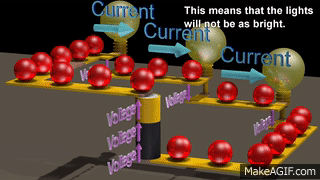The Electron Current
Current is defined as the rate at which charge flows.

Classifications of Current
Direct Current (DC): The current flows in one direction over time, can be constant or time varying
Alternating Current (AC): The current changes direction over time
Time Varying: Any other type of current.
Conventional Current
Conventional Current assumes that current flows out of the positive terminal, through the circuit and into the negative terminal of the source. However, in reality, it is actually the other way around. See Electric Charge.
Charge Carriers
Charges that move in a conductor are called charge carriers. Electrons are the charge carriers in metals, but that is not always the case in ionic solutions or semiconductors.
The electron current is influenced by the number density, the cross-sectional area, and the speed at which they move (drift speed).
Creating a Current
At a microscopic level, electrons are being pushed, and it is this sea of electrons moving through the conductor that is creating the current. However, electrons aren’t moving in a vacuum. There are collisions between electrons and atoms of the metal which transform the electrons’ kinetic energy into thermal energy of the metal. As a result, these collisions will quickly slow down the sea of electrons and stop its motion unless one continues to keep pushing. So how do we do that? With an electric field.
A conductor with electrons moving through it is not in electrostatic equilibrium. An electron current is a nonequilibrium motion of charges sustained by an internal electric field. Let’s look more into this.
Electric Field in a Wire
Say you have a negatively charged plate on the left side connected to wires, as well as a positively charged plate on the right side connected to wires. When the wires are not connected, it is in electrostatic equilibrium, and the electric field inside the wires is zero. Because of this, the surface charge density must be uniform along each wire except near the ends (here the details don’t concern us).
Now, we connect the ends of the wires together. At this moment, the sea of electrons shift slightly and the surface charge is rearranged into a nonuniform distribution. This non-uniform distribution creates a net electric field inside the wire that points from the more positive end of the wire toward the more negative end of the wire. This is the internal electric field E that pushes the electron current through the wire. The excess electrons on the negative wire can now move onto the positive wire that is missing electrons.
The electric field pushes the electron current ie in a direction opposite to E. The conventional current I is in the direction in which the positive charge seems to move.
Notes
- The surface charges are not the moving charges of the current
- The moving charges is inside the wire, not at the surface
A Model of Conduction
Electrons don’t magically move through a wire. They move as a result of an electric field inside the wire, created by a nonuniform surface charge density on the wire, which pushes the sea of electrons to create the electron current.
The magnitude of the electron’s average velocity, due to the electric field, is the drift speed of the electron.